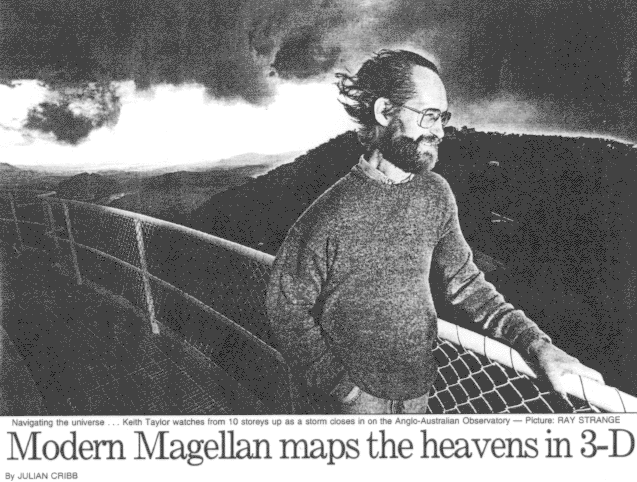
As a tempest bursts over the towering white dome of the Anglo-Australian Observatory, Dr Keith Taylor resembles some mediaeval navigator striding the deck of his storm-tossed barque.
Nor will the outcome of his venture be so different: just as the first world-maps crystallised from the voyages of Diaz, da Gama and Magellan, so the first three-dimensional galactic map will resolve from the AAT's powerful new instrument, the Two Degree Field (2dF).
For the first time we will have a detailed image of the universe we inhabit based on the redshifts of 250,000 galaxies collected over the next two to three years.
The 2dF developed by Dr Taylor and his AAO team represents a dramatic technological advance for Australian astronomy.
Light from the 3.9m primary mirror is focussed into a field two degrees across - the biggest patch of sky yet able to fit down a major telescope.
More than 400 tiny prisms hooked to optical fibres are positioned by a robot - each one zeroed on a particular galaxy.
From there the light passes through a pair of spectrographs which reveal the galaxies' redshift (and hence their three-dimensional location in space).
At the system's heart is a four-element corrector lens, a metre across and one of the largest pieces of glassware ever made. Its job is to focus the light into a flat focal plane and to correct for distortion effects caused by the earth's atmosphere.
The 2dF's robot picks up each prism, which is attached to a small magnet, and places it on a steel plate with astonishing precision - to within five microns - to collect the light from a particular galaxy.
The robot can rearrange all 400 prisms in under 30 minutes, and an ingenious tumbler system enables astronomers to reset the instrument for the next shot while observations are continuing on the previous one.
The spectrographs use aspheric optics and charge-coupled devices to record the light from 400 objects simultaneously. The data is then analysed and stored in a powerful computer.
According to Dr Taylor, the 2dF may also reveal just where modern cosmology is going wrong.
``It's a very exciting time in cosmology: so many new observations are confronting the accepted theories in a dramatic way to give the general impression that somehow, we've got it wrong'', he explains.
For example there is the disagreement over the age of the universe, as measured using different techniques, as well as the issue of the nature of dark matter and its role in the universal structure.
Other tasks for the new instrument include detailed mapping of stars in our own Milky Way galaxy, and the location of more of the enigmatic explosively energetic objects called quasars for what they can tell us about the evolution of galaxies.
Modern Magellan maps the heavens in 3-D, by Julian Cribb